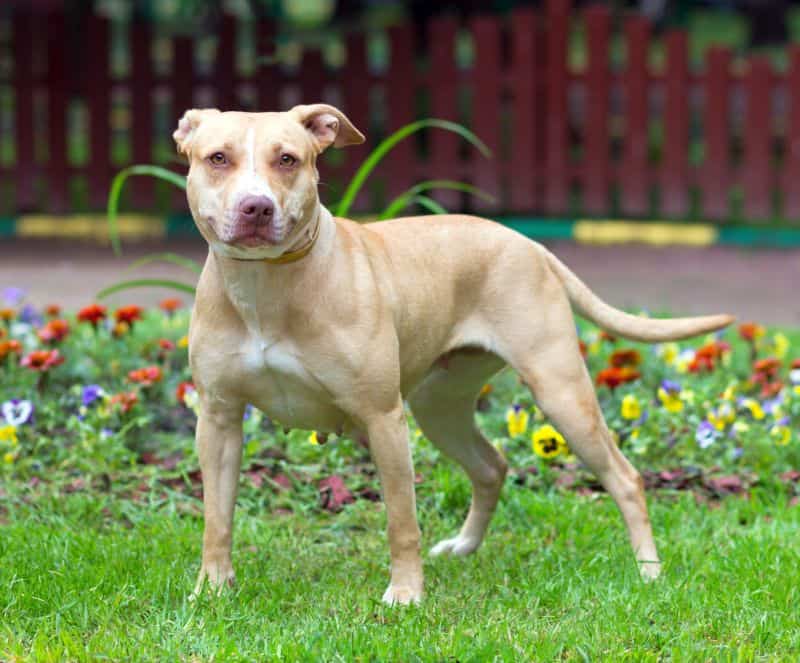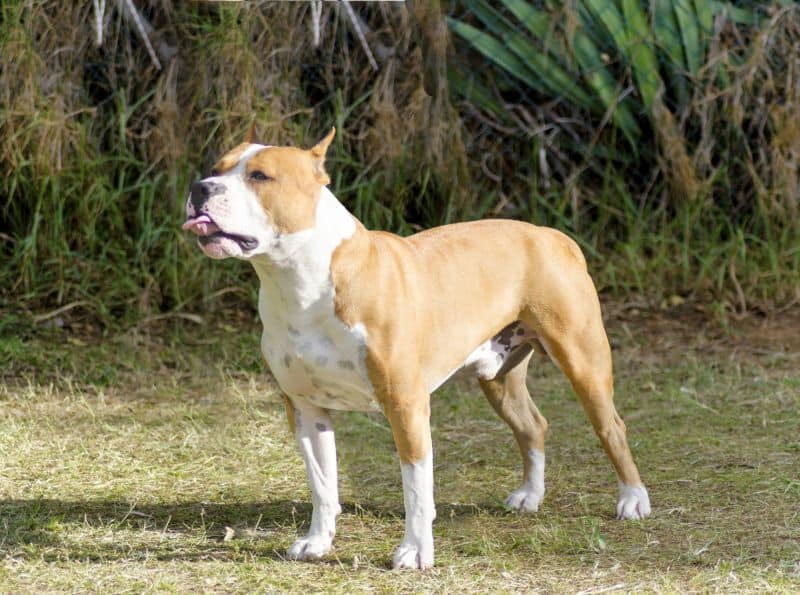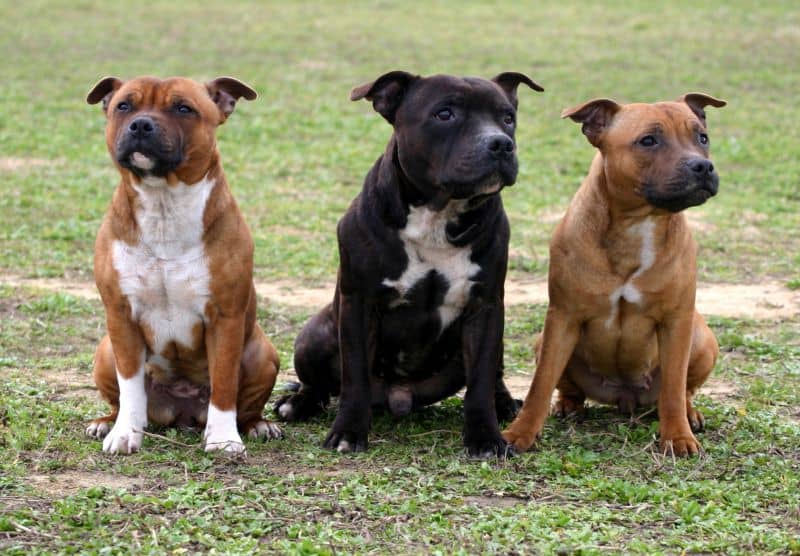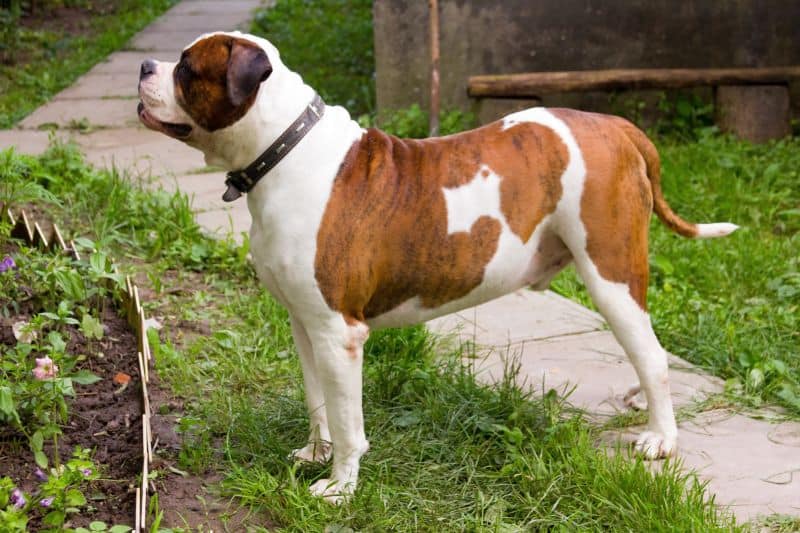Few breeds experience as much misidentification as the pit bull among the countless others. Although the term is nondescript and was taken from the name of the American pit bull terrier, it is frequently used to refer to all dogs with boxy heads, regardless of their breed composition.
In fact, many people refer to a dozen or so different breeds collectively as “bully breeds.” This includes the American pit bull terrier and its closest relatives, in addition to breeds that are less closely related, such as the Dogo Argentino and others.
This is especially regrettable because pit bulls and other bully breeds are frequently the targets of misconceptions, inaccurate information, and unfavorable media coverage. Consequently, they all frequently receive the same unflattering and general portrayal.
We’ll delve into this subject below, clarify what a pit bull is and isn’t, and give you the lowdown on these adorable but sadly misunderstood canines.
What do pit bulls look like as puppies?
The American pit bull terrier’s head is square from the time it is a puppy. Pit bull puppies’ heads appear wrinkled because of the loose skin around them. The sagging skin on the cheeks and thick neck grows as they do. Unless they are cropped, the pointed ears fall forward and stay that way.
What two breeds make a bully?
Molossers crossed with other breeds, such as the Old English bulldog or mastiff breeds, to produce the bullies that we see today. Despite being bred to guard livestock and property at first, some breeders and owners started using the dogs for other, less savory purposes.
Pit bulls are a dangerous breed, and it is detrimental to public safety to hold owners solely responsible for their vicious attacks. According to the victims organization DogsBite, pit bulls account for the vast majority of fatal dog attacks, accounting for 71% of fatalities between 2011 and 2017. org.
The Four Basic Types of “Pit Bulls”
Because different breed registries recognize different breeds, this contributes to the confusion surrounding “pit bulls” and their relatives.
For instance, the United Kennel Club (UKC), the American Kennel Club’s (AKC) counterpart across the pond, does not even recognize the American Pit Bull Terrier (APBT) as a breed. A registry for American pit bull terriers is the American Dog Breeders Association (ADBA).
The lesson is that when talking about related and similar breeds, you must keep breed registries in mind.
Several bully breeds are frequently referred to as “pit bulls” or “pitbulls.” Despite having similar ancestries and large, blocky heads, these dogs are all distinct canines!
These breeds include:

About: The breed behind the “pit bull” name is the American pit bull terrier or APBT. This medium-sized dog is well-known for his loyalty and athleticism, making him a beloved companion. He also goes by the name pit, pittie, pibble, and more, by fans of the breed.
History: It’s a terrible truth, but dogfighting and bull-baiting, two popular blood sports in the 1800s, overshadowed the early years of the APBT.
These dogs were created through the crossbreeding of English bulldogs and terriers, which combined the terriers’ tenacity and athleticism with the bulldogs’ strength.
The dogs quickly became accustomed to one another as their reputation as fearless working dogs made them perfect for life on the farm, where they excelled at hunting and pulling heavy loads. Even on the big screen, the pit bull played the role of the original Petey in the Little Rascals.
Today, APBTs hold a wide range of jobs, including police work, competitive agility, and — perhaps the vocation they’re best suited for — professional couch warming and crumb-between-the-cushion-finding.
The APBT has a sturdy build and measures 17 to 21 inches at the withers. Weights range from 35 to 60 pounds, but a well-bred individual shouldn’t be so big that it affects his gait.
The APBT should go smoothly because he is meant to be an all-around athlete with a confident demeanor. Although it can be thin and whip-like, his tail is long and never docked, per standards, so if he gets excited, watch your legs!
Despite being large, his head should be in proportion to his body, with a broad top and a wide, wrinkle-free muzzle. However, he can have eyes of any color other than blue and should have expressive forehead wrinkles (note that some APBTs may have blue eyes at birth, but they should darken over time). His neck should be thick but not excessively so, and his ears should be set high and fold over.
APBTs have a short coat that is glossy in appearance. His hair can feel quite stiff, and in order to adhere to the standard, it should never be curly, long, or thin.
Colors: Blue, red, black and white, and brindle colorings of APBTs are frequently observed. The terms “red nose pit bull” and “blue nose pit bull,” which are another way of saying a dog with a liver nose or a pup with a black or gray nose, respectively, are frequently associated with the breed. However, per UKC standard, all colors and patterns are acceptable except for merle and albino (yes, there are merle pit bulls).
APBTs have a lifespan of 12 to 14 years and are typically healthy dogs, but there are a few health issues to be aware of, including:
Breed Registries:
APBTs are happiest with their families. They will love their loved ones without condition and are fiercely loyal.
Because of this, they are not a dog that can tolerate spending a lot of time alone in a yard or house without supervision. They frequently experience separation anxiety and will express it by decorating your home with the insides of your favorite throw pillows.
Employing a dog walker or stopping by during your lunch break is a good idea if you anticipate working a long shift, as is crate training.
Though intelligent, the APBT can also be obstinate. Since APBTs can be surprisingly sensitive, firm guidance is required, but always put an emphasis on positive, reward-based training.
Early exposure to people, dogs, and other animals is essential Because of their high prey drive, this breed should never be left unattended outside of a fenced area. When on the move, they can have selective hearing and won’t think twice about chasing after a stray squirrel.
Although pitties struggle in the cold, the APBT’s short coat works well in warmer climates. Limit outdoor activity to brief bathroom breaks when the temperature drops below 40 degrees. Invest in a good coat for walks or research indoor exercise options.
They can be susceptible to ear infections and shed a lot, so keep an eye out for odors or redness.
It should come as no surprise that APBTs need a good deal of exercise given their history as working dogs. This need can be satisfied by a vigorous romp in the backyard or a long, daily walk. In spite of this, APBTs are affectionately known by their owners as “house hippos” because they frequently nap and wallow around the house.

About: The American Staffordshire bull terrier or AmStaff is an early cousin of the ABPT but has distinct differences in size and appearance. He has a larger, heavier look, though he shares the APBT’s legendary loyalty.
History: Staffordshire terriers that had been imported from England were used to breed AmStaffs in the United States in the late 1800s. A larger dog was produced by mating this foundation stock with other terriers, creating the American Staffordshire bull terrier.
The AmStaff, like the APBT, was initially employed in bull baiting and dogfighting but quickly made the transition to work on farms, in the military, and even on film sets. The second dog actor who played Petey in the Little Rascals we discussed earlier was an AmStaff!
Amstaffs have shoulders that are between 17 and 19 inches wide. They are proportionately tall and weigh between 40 and 75 pounds on average. His physique must be athletic, muscular, and stocky; he must never have a leggy appearance.
The broad head of the AmStaff features a full muzzle and widely spaced, dark eyes. His ears sit high, may rise or rest half-risen, but never hang as per the norm. He has a strong neck with no loose skin, powerful shoulders, a short back, and a thin tail that hangs low to the ground.
The short, glossy coat of the AmStaff has a stiff, pricked texture. Since all AmStaffs have black noses as per the norm, they are not distinguished by the terms “red nose” and “blue nose” like APBTs are.
AKC guidelines state that AmStaffs are acceptable in a wide range of hues and patterns, but full-body white, liver, or black and tan aren’t encouraged.
The average lifespan of the AmStaff breed, which is generally healthy, is between 12 and 14 years. However, he is prone to a few health issues, such as:
Breed Registries:
The AmStaff is a self-assured breed with documented courage, but he can be a goofball at home.
He loves his family dearly and is eager to please and play, so he needs a lot of daily care. Make sure you’re prepared to commit to a cute, attention-seeking dog because he can’t handle being ignored or left outside.
He requires early, persistent training with plenty of high-value incentives. This entails regular obedience training in addition to socialization with other dogs, people, and animals. He is sensitive and should never be reprimanded harshly if he steps out of line because all he wants is to see his humans happy. Keep your AmStaff on a leash at all times when he is outside of fenced areas because he has a healthy prey drive as well.
With their short coats, AmStaffs don’t require a lot of grooming, but you should wash him as necessary and keep an eye out for any signs of sensitivity in his ears and toes. He doesn’t shed a ton, but he may drool.
Your AmStaff is a working dog at heart, so while he doesn’t mind hanging out with you while you watch Netflix, he should be taken for daily walks and engage in regular playtime to burn off excess energy.
Regular exercise will not only make him feel better, but it can also help him maintain a healthy weight (these pooches can put on weight if you’re not careful).

About: The Staffordshire bull terrier or Staffy is an older breed than the previous two and led to their development (it should also be noted that the Staffy is the only one of the three recognized by both the AKC and UKC).
The Staffy, a small dog with surprising strength, is adored for his silly personality and “smiling” appearance.
History: The Staffy’s history is, not surprisingly, quite similar to that of APBTs and AmStaffs. Staffies were created for blood sports, with the bulldog serving as their primary ancestor.
Despite having horrifying origins, the Staffy went on to become a cherished pet all over the world. He is not only a good house dog, but also earned his keep by eradicating unwanted pests like rats because he is a terrier at heart.
Description: Staffies stand 14 to 16 inches at the shoulder. Weight varies from 24 to 38 pounds. He should be athletic but not overly bulky, and he shouldn’t struggle to move fluidly or look cartoonish. He is a sturdy dog with broad shoulders and a thick neck, which complement his overall shape.
The Staffy’s short, broad head has defined cheekbones that give him the aforementioned “smile.” His eyes should be dark, and his nose is always black. He has a generally alert, worried look on his face, and his ears are up but folded at the ends.
Short and smooth staffies should always have a shiny appearance.
Staffies are available in a variety of hues, including brindle, fawn, black, and blue. According to the standard, only the liver and the black-and-tan pattern are prohibited.
Staffies generally have good health and have a lifespan of 12 to 14 years. They do have some health concerns in their history, including:
Breed Registries:
A Staffy is ideal for a family because his heart is the only thing bigger than his smile. He thrives when he serves as the head of the family and enjoys spending time with his four-legged friends. Due to his sensitivity, he should never be left alone in a yard or kennel.
It’s essential to socialize children with other people, dogs, and other animals to prevent aggression.
One of the hardest breeds on our list to train is the Staffy. He is not a dog for beginners because he is intelligent and frequently believes that he knows what’s best. Positive reinforcement is crucial for early control of this independent streak.
Because of his prey drive, which compels him to chase anything he sees, whether it’s a bunny or a bag drifting, you should never leave him unattended in an open area.
Regular shedders, your Staffy will leave his short, spiky hair behind on furniture. Brushing as needed can cut down on these deposits.
Staffies require daily exercise to stay content. His needs for both physical and mental stimulation can be met with a protracted, meandering walk or hike with lots of sights and smells. He also thrives with high-intensity exercises, such as jogging.
However, due to his shorter muzzle, keep in mind that in warmer weather he may become overheated.

About: The American bulldog is a strong working breed built to be a farmer’s right-hand doggo. He shares a pittie’s solid form and large, blocky head, but he’s much bigger.
The American bulldog was developed in America in the 1700s using a combination of imported bulldogs from England. He was created to play a variety of roles on a property, such as guard, catch dog, and herder. Over the years, his appeal waned, but it recently returned.
American bulldogs measure 20 to 28 inches tall at the withers. Weights vary from 60 to 120(!) pounds depending on sex. His muscled body should still allow for a smooth gait. Although he is well-boned and built, he shouldn’t appear excessively round or large like the more well-known (English) bulldog.
His wide, broad head has a prominent jowl and a broad muzzle. His ears are perked up and he always has an alert expression. Dark brown eyes are preferred but not necessary. The majority of American bulldogs have black noses, but red and brown schnozzes are also acceptable.
The American bulldog’s coat is stiff to the touch and less than an inch long. It should never wave or curl and always lay flat.
American bulldogs come in a wide range of hues and patterns, such as white, fawn, and brindle. Solid black, solid blue, tricolor, merle, and a solid black mask are the only colors that are ineligible.
The American bulldog has a lifespan of 10 to 15 years, which is longer than that of most bulldogs, but he also has a number of notable health issues, including:
Breed Registries:
American bulldogs make excellent family pets and are fiercely devoted to their owners. Although he is renowned for his sloppy kisses, he won’t give them to strangers. Because he is naturally wary of unfamiliar people or dogs, make sure he is well socialized from the time he is a puppy onward to prevent problems.
For a bulldog, he’s on the easier side to train. He responds well to rewards and learns quickly. Make sure you don’t use too much repetition or he’ll quickly tune you out because he can be stubborn when under-exercised or bored. Combining learning with fun and play breaks is ideal.
He’s a regular shedder, though it isn’t an overwhelming amount. His short coat requires only brushing to remove loose hair and bathing when it gets dirty, making it simple to maintain.
American bulldogs need daily exercise. He is the ideal breed choice for a running companion, though a long hike or walk combined with fetch or tug-of-war games also works well.
He can’t let off steam in the backyard by himself like some dogs can. If you’re pressed for time, hiring a dog walker is essential because he’ll become frustrated and destructive.
FAQ
How can I tell what breed my pitbull is?
Check for a broad, wedge-shaped head and thick neck. Due to the dog’s long muzzle and low forehead, its head will likely appear wide and slightly rounded from the front, but wedge-shaped from the side. This head shape, along with a number of other traits, derives from the fighting heritage of pitbull-type dogs.
What are the three types of Pitbull?
- The tallest and most athletic variety of pit bulls is the American Pit Bull Terrier.
- A squat, stocky dog first developed in the 1980s and 1990s, the American Bully
- American Staffordshire Terrier: Possibly the most playful pit bull, this breed is a little shorter and heavier than the American Terrier.